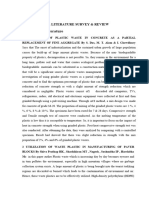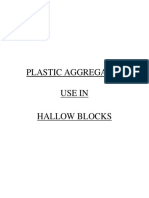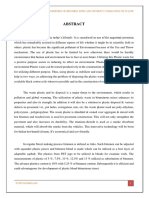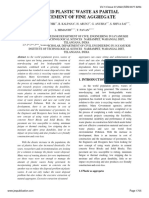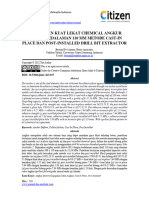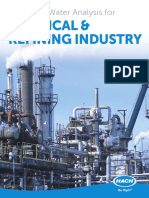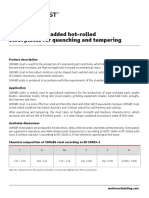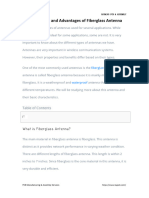Professional Documents
Culture Documents
A Survey of The Plastic Waste Used in Paving Blocks
A Survey of The Plastic Waste Used in Paving Blocks
Original Title
Copyright
Available Formats
Share this document
Did you find this document useful?
Is this content inappropriate?
Report this DocumentCopyright:
Available Formats
A Survey of The Plastic Waste Used in Paving Blocks
A Survey of The Plastic Waste Used in Paving Blocks
Copyright:
Available Formats
Volume 9, Issue 4, April – 2024 International Journal of Innovative Science and Research Technology
ISSN No:-2456-2165 https://doi.org/10.38124/ijisrt/IJISRT24APR940
A Survey of the Plastic Waste used in Paving Blocks
Piyush V. Patil
Department of Civil Engineering Sanjivani K.B.P Polytechnic, Kopargaon
Abstract:- Plastic is a material that does not degrade in the forms of plastic waste as a binding agent that can totally displace
environment. Step by step, the volume of plastic garbage in cement. The components of a paver block are made of a mixer
municipal solid waste is growing rapidly. Hydrocarbons, that mixes fine aggregate from nature with various kinds of
which can be obtained from a variety of sources including plastic trash in varying amounts. Both financial and
coal, oil, and certain minerals, are used to make plastic. environmental benefits result from substituting plastic waste for
Plastic is considered useful during a time of scarcity, however cement. The results of the investigation indicate that sand can be
after it is used, it is practically thrown away, posing a variety mixed with different polymers without compromising its other
of risks There are many different types of plastic, such as characteristics or weakening it slightly, where paver bricks are
Low Thickness Poly-ethylene (the material) and High made by melting or shredding materials. The amount of plastic
Thickness Poly- ethylene (HDPE). These leftover polymers that is used such as the use of PET containers, tote bags, cups,
are then to be effectively utilized in the production of paver and other items is ever growing. Once used plastic is thrown
squares. In order to produce high- quality blocks with warm away, it does not biodegrade. They are therefore either burned or
and sound protection qualities to cope with contamination dumped in a landfill. Because they damage the air and soil,
and to lower the overall cost of construction, low thickness neither process is beneficial to the environment. Any technique
polyethylene is spotlessly mixed in with the sand and that can make use of this waste plastic for the construction's goal
aggregate at varying rates. development, this is likely the best is always acknowledged. Polymer compounds are used to make
way to prevent the accumulation of plastic garbage, a non- plastic, and they are nondegradable. Plastic is a material that is
biodegradable poison. The goal of this initiative is to use both extremely helpful and dangerous. Plastic is a hazardous
plastic waste as a binder instead of cement, which will material that is not biodegradable and can persist for decades
decrease the decrease the need for cement and lower the when use improperly the amount of plastic Municipal Solid
price of paver blocks. The country produces over 5.6 million Waste (MSW) is rapidly growing in volume of waste. The rate
tone of plastic garbage annually. Plastic disintegration is a of expansion is thought to double every ten years.
very drawn-out process that takes several years. Thus, it
makes sense to employ plastic trash in paver blocks. We have II. LITERARTURE REVIEW
mixed fine and coarse gravel with plastic trash in different
proportions for this technique. After being assembled, the Pooja Bhatia Due to challenges encountered in the steps of
paver squares were tested. The square plastic paver's sample collection and treatment, the majority of developing
maximum capacity to retain water is When compared to countries do not have an adequate solid waste management
paver square, the results showed greater quality. system in place. Because low-density polyethylene (LDPE) is
widely used in products like wrapping paper, thin bags, water
Keywords:- Plastic Waste Used in Paver Block Plastic Waste, sachets, and more, it is one of the main sources of this kind of
Low Density Polyethylene, Polyethylene Properties, Plastic pollution. The groundwater table and the nearby soil will be
Paving Block. impacted by the waste plastic that is being dumped in landfills.
This research proposes a reasonably simple process for
I. INTRODUCTION producing LDPE-bonded sand blocks and pavers. It was
discovered that when the sand's particle size shrank, the density
Solid waste management is still an important problem, and compressive strength rose. Additionally, the samples' impact
especially for low and middle-income countries when it comes to resistance was significantly better than that of conventional clay
urban areas. The plastic debris used in this project came from paver blocks.
then neighbourhood. At the moment, 25,940 ton of plastic waste
are produced every day, or 9.46 million ton annually among the Aarti Ghude- Plastic is a material that does not decompose.
biggest Polypropylene and polyethylene make up a portion of Every day, there is a sharp increase in the amount of plastic
plastic rubbish. Because it affects people as well as animals waste in municipal solid waste. When plastic is required, it is
directly and indirectly, disposing of waste pollutes the crucial to use it at that moment because it can be reused
environment around it. The ecosystem, marine life, humans, and afterwards. Plastic comes in a variety of forms, particularly
animals are all seriously damaged by the billions of tone of High-Density Poly-ethylene (HDPE). The goal of this research is
plastic waste that wind up in the world's oceans. In order to to use melted plastic trash to replace the bonding that cement
produce cement-less pavers, the current study presents several provides in paver blocks. Plastic disintegration is an extremely
IJISRT24APR940 www.ijisrt.com 807
Volume 9, Issue 4, April – 2024 International Journal of Innovative Science and Research Technology
ISSN No:-2456-2165 https://doi.org/10.38124/ijisrt/IJISRT24APR940
drawn-out process that could take thousands of years. As a B. Proper Mix Design. (1:3).
result, a project adds to less plastic waste. In this study, we Plastic melts when heated to between 140 and 160 degrees
combined fine and coarse gravel in varying proportions with Celsius, and the resulting liquid is measured in milli litre. When
plastic garbage. The paver pieces completed preparation and ½ kg of plastic bags are heated to 450 ml of liquid, what
testing. happens? In a similar vein, the ratio of plastic mix proportion is
plastic's ability to absorb water
S. Arjun Kumar S. Ganesh Babu in addition with waste
plastic waste lime sludge from the paper industry C. Command Experiment
replaces fine aggregate. about all test. Because of population Use plastic and sand in the project to ensure that the paving
increment the production of plastic material and surroundings. blocks are correct in shape. Usually, water is used to mix
Sand is added to heated waste plastic, a process that can be done cement, sand, and aggregate to make concrete pavement blocks.
both mechanically and manually. In the current project, plastic While the recycled plastic paving block only needed sand and
pavers are created by adding 40%, 50%, 60%, and 70% of waste plastic, regular pavement components use cement as its binding
plastic to the weight of sand needed to fill the paver mould. It is component. where the paving block's plastic binder can be used.
discovered from those four trials that, in order to acquire the
appropriate mould shape, at least 60% waste additive and 70% D. Blend the Design
waste additive are needed. The design of the plastic paving block mix is not properly
established through the entire manufacturing process. The
Avinash G B, Roja A P, Santosh M Waste plastic is used to producing process' trial-and-error methodology is what this mix
prepare the into required mould. In these projects we use the design is based on.
normal brick sizes Plastic Pavers. A significant amount of plastic
is being transported into the (15*15*6 cm). After 2 days remove E. Forming and Releasing Moulds
the brick from the mould and separating areas, where it is either In project, we have to use lime sludge, waste plastic in
burned or disposed of, polluting the air then done curing. different proportion Because the material is excessively hot,
handle the appropriate metal drum with sand. The paver block is
Avinash Gb, Rosa Ap, Santosh M R, Puneetha kumari H M tested and we discussed by carrying out the moulded and mix
We may use waste plastic as cement in our project, and we'll use procedure. filled the mould with the levelled it properly, and
the plastic to make pavement blocks instead of throwing it away tamped it down to prevent any voids waste is also increased.
because it's affordable and readily available The plastic We will be using the method of assistance of a trowel.
pavement block weighs less than the concrete pavement block. It Remove the mould once the mixer has solidified land filling for
also offers a brief process for creating a block. disposal of plastic which is very important. so, we can use
Nonbiodegradable plastic garbage is expanding quickly and enough so that the slab will not collapse. In about two hours, it
posing a hazard to the environment in a number of ways. ought should the plastic in paver block establish.
III. MATERIAL AND METHODOLOGY IV. MOULDING
Selection of material After Completion of Proper Mixing We Place Mix.
Checking the material properties.
Proper mix design for the recycled plastic using paving
block.
Melting the plastic waste, at the temperature of 140 0C to
160 0 C.
Mixing of sand in melted plastic.
Molding.
Unmolding.
A. Choice of Content
The production of paver blocks requires a lot of plastic.
Analysis showed that 3 kg of sand were needed for every 1 kg of
plastic. The total quantity of sand necessary depends on weather
plastic is used for the blocks.
Fig 1: Mould
IJISRT24APR940 www.ijisrt.com 808
Volume 9, Issue 4, April – 2024 International Journal of Innovative Science and Research Technology
ISSN No:-2456-2165 https://doi.org/10.38124/ijisrt/IJISRT24APR940
There's no need to cure.
Compared to regular pavement blocks, plastic paving blocks
arelighter.
Paving blocks can withstand moisture.
Durability comparisons between conventional paving blocks
and plastic-used paving blocks
7. Degradation takes many years.
When plastic bags disintegrate in the sun, toxic substances
are released into the soil.
Burning plastic bags releases a poisonous gas into the
atmosphere, causing air pollution.
When animals consume poorly disposed of food bags, they
can develop illnesses related to the stomach and intestines
that can potentiallyresult in asphyxia and death.
The dispersal of plastic in open areas leads to unsanitary
conditions since it serves as a breeding ground for mosquitoes
Fig 2: Plastic Paver Block and insects that spread diseases like malaria and dengue
A. Aim C. Application
The purpose of this project is to lower the cost of paver
blocks relative to traditional concrete paver blocks and substitute Paver Square's usage of discarded plastic offers a profitable
cement with plastic waste. Determining the appropriateness of option toget rid of plastic trash.
the garbage is the aim of this investigation. Polyethylene bags, It can be used in gardens, pathways for bicyclists and
plastic containers as well as additional substances in the process pedestrians, and so forth.
of generating paver blocks for building. Since it is not water permeable, there is almost no risk of
owing to green growth and organisms.
B. Objective It can be applied to roads with little or no traffic.
A 15% weight reduction is achieved by employing plastic in
Plastic is used in place of cement. paverblocks.
It takes less of a perfect occasion to create
Shorten the paving block's setting time.
Lower the price of paving blocks.
Fig 1: Method of Plastic Paver Block
IJISRT24APR940 www.ijisrt.com 809
Volume 9, Issue 4, April – 2024 International Journal of Innovative Science and Research Technology
ISSN No:-2456-2165 https://doi.org/10.38124/ijisrt/IJISRT24APR940
Advantages of Plastic Paver Block REFERENCES
It has strength and durability. [1]. Ghuge, J., Surale, S., Patil, B. M., & Bhutekar, S. B.
Compact (2019). Utilization of waste plastic in manufacturing of
streamlines the installation of energy paver blocks. System, 6(04), 1967-1970.
Increased thermal safeguarding [2]. Goyal, H., Kumar, R., & Mondal, P. (2023). Life cycle
Environmentally friendly analysis of paver block production using waste plastics:
Cost effective [3]. Comparative assessment with concrete paver blocks.
Low maintenance Journal of Cleaner Production, 402, 136857.
[4]. Agyeman, S., Obeng-Ahenkora, N. K., Assiamah, S., &
Disadvantages of Plastic Paver Block Twumasi, G. (2019). Exploiting recycled plastic waste as
an alternative binder for paving blocks production. Case
Decreased density limited Studies in Construction Materials, 11, e00246.
load bearing capacity [5]. Anusha, G., & Dineshkumar, R. (2022). Study on paver
insufficient fire resistance blocks using waste plastics and sugarcane bagasse ash.
Materials Today: Proceedings, 68, 2088-2092.
Self Safety Equipments [6]. Suchithra, S., Oviya, S., Rethinam, S. R., & Monisha, P.
(2022). Production of paver block using construction
Masks demolition waste and plastic waste–A critical review.
Gloves Materials Today: Proceedings, 65, 1133-1137.
dungarees [7]. Tempa, K., Chettri, N., Thapa, G., Gyeltshen, C., Norbu,
Covered D., Gurung, D., & Wangchuk, U. (2022). An
Boots experimental study and sustainability assessment of
Shoes plastic waste as a binding material for producing
economical cement-less paver blocks. Engineering
V. FUTURE SCOPE Science and Technology, an International Journal, 26,
101008.
A big entrance with lavish outdoor flooring is necessary for
bungalow and apartment landscaping; there are other options, but
the most crucial thing is to draw attention to the features. I am
convinced that using plastic paver bricks is the most sensible,
economical, and simplest way to accomplish the goal. Plastic
pavement blocks are rather stiff and difficult for pedestrian and
vehicle traffic because they are industrial items. These long-
lasting, aesthetically pleasing precast pavers require little to no
maintenance when constructed and installed correctly. Plastic
paver blocks are a typical material that have many uses in hard
landscaping.
VI. CONCLUSION
According to the analysis of the previously mentioned
research, waste plastic can be used to make pavement blocks.
This modified pavement block can be used for pedestrian
construction, public buildings, government buildings, educational
facilities and other low-traffic spots for parking. The waste that's
left in the block is plastic. For fine aggregate, various quantities of
waste plastic are utilized for varied workability, durability, and
compressive strength and, most importantly, to minimize the
amount of plastic waste.
IJISRT24APR940 www.ijisrt.com 810
You might also like
- Welders CertDocument11 pagesWelders CertAhmed GomaaNo ratings yet
- Waste Plastic As AggregateDocument9 pagesWaste Plastic As AggregateFrank PingolNo ratings yet
- Plastic Bricks PDFDocument6 pagesPlastic Bricks PDFHasita Krovvidi100% (2)
- Chapter 1 5 and AppendicesDocument73 pagesChapter 1 5 and Appendicesjohn-john castañedaNo ratings yet
- Material Compliance-New DesignDocument6 pagesMaterial Compliance-New DesignvtalexNo ratings yet
- Fair-Faced ConcreteDocument92 pagesFair-Faced Concreteec021600% (1)
- Plastic Waste ThesisDocument19 pagesPlastic Waste ThesisCj MoLanoNo ratings yet
- Bio-aggregate-based Building Materials: Applications to Hemp ConcretesFrom EverandBio-aggregate-based Building Materials: Applications to Hemp ConcretesSofiane AmzianeNo ratings yet
- DESIGN REPORT OF Kalanki RESIDENCEDocument23 pagesDESIGN REPORT OF Kalanki RESIDENCESuyogya DahalNo ratings yet
- Bio-Eco Paver Block (BEPB)Document20 pagesBio-Eco Paver Block (BEPB)Madzkhil Madrona100% (2)
- Reuse of Plastics Waste For The Production of Floor TilesDocument8 pagesReuse of Plastics Waste For The Production of Floor TilesKi Tibebu MaNo ratings yet
- Utilization of Plastic Waste For Making Plastic BricksDocument3 pagesUtilization of Plastic Waste For Making Plastic BricksEditor IJTSRD100% (1)
- Ibis Textiles Directory 2023 SampleDocument13 pagesIbis Textiles Directory 2023 Samplesujan mehtaNo ratings yet
- FLOORWAXDocument30 pagesFLOORWAXALTHEA BORJANo ratings yet
- Investigatory ProjectDocument16 pagesInvestigatory ProjectSunog-Kilay TutorialsNo ratings yet
- The Gas Laws: 1.boyle's Law 2.charles' Law 3.Gay-Lussac's Law 4.avogadro's LawDocument20 pagesThe Gas Laws: 1.boyle's Law 2.charles' Law 3.Gay-Lussac's Law 4.avogadro's Lawdavid jenil nabua100% (1)
- Green DevelopmentDocument5 pagesGreen Development565Kartik SuryavanshiNo ratings yet
- Litreatrature - Review RakshitDocument9 pagesLitreatrature - Review Rakshitparasajit89No ratings yet
- Final JournalDocument4 pagesFinal Journalpavan v vNo ratings yet
- GGHH Unselected Edited Signed Signed Edited-NumberedDocument24 pagesGGHH Unselected Edited Signed Signed Edited-Numberedsumanpanditjay854105No ratings yet
- Implementation of Plastic Waste in Manufacturing of Paving Blocks For Different ShapesDocument2 pagesImplementation of Plastic Waste in Manufacturing of Paving Blocks For Different ShapesEditor IJTSRDNo ratings yet
- Partially Replacing Aggregates in Concrete With Plastic Waste Review Ijariie15232Document6 pagesPartially Replacing Aggregates in Concrete With Plastic Waste Review Ijariie15232StephenNo ratings yet
- Plastic Aggregates Use in Hallow BlocksDocument12 pagesPlastic Aggregates Use in Hallow BlocksEdison KingNo ratings yet
- Binding Material in Pavement Block Made From Waste PlasticDocument5 pagesBinding Material in Pavement Block Made From Waste PlasticAbdelrahman AshmawyNo ratings yet
- Major Project ReportDocument28 pagesMajor Project Reportsankitlp801104No ratings yet
- Report Black BookDocument54 pagesReport Black BookSanket ChaudhariNo ratings yet
- Proposal ReportDocument26 pagesProposal ReportKALEMA BEMME2025No ratings yet
- Living and Group Project WorkDocument15 pagesLiving and Group Project Workselorm7tettehNo ratings yet
- Shredded Recycled Plastic Bottles As Additive in Road ConcreteDocument26 pagesShredded Recycled Plastic Bottles As Additive in Road ConcreteerrolNo ratings yet
- Use of Waste Plastic in Concrete Mixture As Aggregate ReplacementDocument4 pagesUse of Waste Plastic in Concrete Mixture As Aggregate ReplacementIJAERS JOURNALNo ratings yet
- Plastics Could Help Build A Sustainable Future - Here's HowDocument4 pagesPlastics Could Help Build A Sustainable Future - Here's HowanuragNo ratings yet
- ANDIA, Background XDocument3 pagesANDIA, Background XAndrea Mae SanchezNo ratings yet
- 9.reprocessing of Low-Density Polyethylene (LDPE) Waste Materials For The Formation of PVC Ceiling Tiles Using Sawdust As A ReinforcementDocument8 pages9.reprocessing of Low-Density Polyethylene (LDPE) Waste Materials For The Formation of PVC Ceiling Tiles Using Sawdust As A ReinforcementRachel DelosreyesNo ratings yet
- A Major ProjectDocument16 pagesA Major ProjectRajuNo ratings yet
- Plastic Roads A Seminar Report SubmittedDocument18 pagesPlastic Roads A Seminar Report SubmittedritikNo ratings yet
- Irjet V8i1154Document6 pagesIrjet V8i1154Kirby LabadanNo ratings yet
- Literature ReviewDocument4 pagesLiterature Reviewmt22tre002No ratings yet
- "Making of Economical Tiles Using Plastic Waste": Project Presentation OnDocument38 pages"Making of Economical Tiles Using Plastic Waste": Project Presentation OnShantanu JadhavNo ratings yet
- Ijce V6i7p101Document6 pagesIjce V6i7p101Ibrahim Tuhin PICUNo ratings yet
- General: A Study On Strengthen The Concrete by Coarse Agfregates Coated With College Waste PlasticDocument47 pagesGeneral: A Study On Strengthen The Concrete by Coarse Agfregates Coated With College Waste PlasticpraneethNo ratings yet
- Fin Irjmets1653790300Document6 pagesFin Irjmets1653790300johnopira3No ratings yet
- Readings On Lit.Document17 pagesReadings On Lit.bevelyn caramoanNo ratings yet
- 2022 V13i7247Document5 pages2022 V13i7247Ibrahim Tuhin PICUNo ratings yet
- c1 c5 CompleteDocument44 pagesc1 c5 CompleteAbdulaziz KhalilNo ratings yet
- Final DraftDocument35 pagesFinal DraftSrikanth S SanamoNo ratings yet
- Main PagesDocument32 pagesMain PagesSrikanth S SanamoNo ratings yet
- 2nd Avinash Kumar 7june19Document11 pages2nd Avinash Kumar 7june19Anshuman SinghNo ratings yet
- .Utilization of Plastic Waste and Artificial Sand in Manufacturing of Eco BricksDocument3 pages.Utilization of Plastic Waste and Artificial Sand in Manufacturing of Eco BricksSande NasNo ratings yet
- Effectiveness of Pet Plastic As The Main Component in Making Cement BricksDocument36 pagesEffectiveness of Pet Plastic As The Main Component in Making Cement BricksRose Mae TrillesNo ratings yet
- Recycling of Waste Water Bottles Into Composite Floor Tile: Presented by Shrinath. S. KshirsagarDocument16 pagesRecycling of Waste Water Bottles Into Composite Floor Tile: Presented by Shrinath. S. KshirsagarmohammedNo ratings yet
- Edit Final Thesis of ProjectDocument54 pagesEdit Final Thesis of ProjectAshok KumarNo ratings yet
- CITATION Jen15 /L 13321Document2 pagesCITATION Jen15 /L 13321Kent Aldwin MangalinoNo ratings yet
- PaverDocument29 pagesPaverJeevan Landge PatilNo ratings yet
- Waste Plastic GoooodDocument12 pagesWaste Plastic GoooodAngel AngelNo ratings yet
- Use of Plastic Waste in Flexible Pavements: Volume 2, Issue 4, April 2013Document13 pagesUse of Plastic Waste in Flexible Pavements: Volume 2, Issue 4, April 2013International Journal of Application or Innovation in Engineering & ManagementNo ratings yet
- Litrecher ReviwDocument4 pagesLitrecher ReviwJITESH RATHINo ratings yet
- Compressive Strength and Bulk Density of PDFDocument10 pagesCompressive Strength and Bulk Density of PDFjenecil budionganNo ratings yet
- 1 5Document37 pages1 5john-john castañedaNo ratings yet
- Seminar Report Plastic Road PDFDocument13 pagesSeminar Report Plastic Road PDFAbhinav YadavNo ratings yet
- Experimental Investigation On Use of Recycled Aggregate and Waste Plastic For Manufacturing Eco Friendly Solid BrickDocument6 pagesExperimental Investigation On Use of Recycled Aggregate and Waste Plastic For Manufacturing Eco Friendly Solid BrickloocshanemaeNo ratings yet
- A Review Paper On "Utilization of Fly Ash, Rice Husk Ash and Plastic Waste in Paver Blocks"Document4 pagesA Review Paper On "Utilization of Fly Ash, Rice Husk Ash and Plastic Waste in Paver Blocks"Aragorn RingsNo ratings yet
- Parative Analysis of Tiles Made From Recyclable LDPE Plastic WasteDocument5 pagesParative Analysis of Tiles Made From Recyclable LDPE Plastic WasteRachel DelosreyesNo ratings yet
- Wa0001.Document4 pagesWa0001.layakaruvanpadiNo ratings yet
- Papercrete Brick As An Alternate Building MaterialDocument9 pagesPapercrete Brick As An Alternate Building MaterialHhuNo ratings yet
- Experimental Analysis of Polymer Insertion in Bricks Formation Under Sustainable Development ApproachDocument8 pagesExperimental Analysis of Polymer Insertion in Bricks Formation Under Sustainable Development ApproachIJRASETPublicationsNo ratings yet
- The Sustainable Solution: Plastic Granulate Production in Action: Money from trashFrom EverandThe Sustainable Solution: Plastic Granulate Production in Action: Money from trashNo ratings yet
- Study of prevalence of Head Lice (Pediculus Humanus Capitis) Among Schoolchildren in the Zawiya Region, LibyaDocument10 pagesStudy of prevalence of Head Lice (Pediculus Humanus Capitis) Among Schoolchildren in the Zawiya Region, LibyaInternational Journal of Innovative Science and Research Technology0% (1)
- The Expanding Attack Surface: Securing AI and Machine Learning Systems in Security OperationsDocument8 pagesThe Expanding Attack Surface: Securing AI and Machine Learning Systems in Security OperationsInternational Journal of Innovative Science and Research Technology100% (1)
- Utilizing Chicken Eggshells and Waste Glass Powder as Cement Fillers for Environmental StabilityDocument6 pagesUtilizing Chicken Eggshells and Waste Glass Powder as Cement Fillers for Environmental StabilityInternational Journal of Innovative Science and Research TechnologyNo ratings yet
- The Impact of Termite Activity on the Availability of Soil Micronutrients in Tropical RegionsDocument6 pagesThe Impact of Termite Activity on the Availability of Soil Micronutrients in Tropical RegionsInternational Journal of Innovative Science and Research Technology100% (1)
- Teacher-Induced Academic Stress: Predicting Eating Behavior Problems in College StudentsDocument8 pagesTeacher-Induced Academic Stress: Predicting Eating Behavior Problems in College StudentsInternational Journal of Innovative Science and Research TechnologyNo ratings yet
- Modern Approaches to Sustainable AgricultureDocument10 pagesModern Approaches to Sustainable AgricultureInternational Journal of Innovative Science and Research Technology100% (1)
- Integrating Quantum Algorithms with Gravitational-Wave Metrology for Enhanced Signal DetectionDocument18 pagesIntegrating Quantum Algorithms with Gravitational-Wave Metrology for Enhanced Signal DetectionInternational Journal of Innovative Science and Research Technology100% (1)
- Personal Capabilities of The Non-Teaching Personnel and Client SatisfactionDocument8 pagesPersonal Capabilities of The Non-Teaching Personnel and Client SatisfactionInternational Journal of Innovative Science and Research TechnologyNo ratings yet
- Solar Based Multilevel Inverter F o R BLDC Motor DriveDocument8 pagesSolar Based Multilevel Inverter F o R BLDC Motor DriveInternational Journal of Innovative Science and Research TechnologyNo ratings yet
- Assessment of Integrated Poultry Manure and Synthetic Fertilizer Effects on Maize (Zea mays) Growth and Soil Properties: A Study from Bayero University, KanoDocument15 pagesAssessment of Integrated Poultry Manure and Synthetic Fertilizer Effects on Maize (Zea mays) Growth and Soil Properties: A Study from Bayero University, KanoInternational Journal of Innovative Science and Research Technology100% (1)
- The Influence of Continuance Commitment on Job Satisfaction of Barangay Health Workers in Malaybalay City, BukidnonDocument14 pagesThe Influence of Continuance Commitment on Job Satisfaction of Barangay Health Workers in Malaybalay City, BukidnonInternational Journal of Innovative Science and Research TechnologyNo ratings yet
- Transforming Challenges to Victories: An Inquiry on Transformational Leadership of School Leaders in the Public Elementary SchoolsDocument54 pagesTransforming Challenges to Victories: An Inquiry on Transformational Leadership of School Leaders in the Public Elementary SchoolsInternational Journal of Innovative Science and Research TechnologyNo ratings yet
- Design and Development of Multi-Featured Medical StretcherDocument4 pagesDesign and Development of Multi-Featured Medical StretcherInternational Journal of Innovative Science and Research TechnologyNo ratings yet
- Seasonal Variation and Distribution Patterns of Endophytic Community in Withania SomniferaDocument7 pagesSeasonal Variation and Distribution Patterns of Endophytic Community in Withania SomniferaInternational Journal of Innovative Science and Research TechnologyNo ratings yet
- Meta Land: Redefining Virtual Communities Through Centralized Governance, Inclusivity and InnovationDocument5 pagesMeta Land: Redefining Virtual Communities Through Centralized Governance, Inclusivity and InnovationInternational Journal of Innovative Science and Research TechnologyNo ratings yet
- Smart and Secure Home With ChatbotDocument9 pagesSmart and Secure Home With ChatbotInternational Journal of Innovative Science and Research TechnologyNo ratings yet
- Exploring The Potential Advantages of Traditional Therapies in Autoimmune Blistering Illnesses: A Comprehensive Review and Analysis, ResearchDocument12 pagesExploring The Potential Advantages of Traditional Therapies in Autoimmune Blistering Illnesses: A Comprehensive Review and Analysis, ResearchInternational Journal of Innovative Science and Research TechnologyNo ratings yet
- Skin Disease Detection and Remedial SystemDocument7 pagesSkin Disease Detection and Remedial SystemInternational Journal of Innovative Science and Research TechnologyNo ratings yet
- Strategic Deployment of Ducklink Wireless Devices For Disaster Mitigation and Management in Nueva ECIJA University of Science and Technology Sumacab CampusDocument13 pagesStrategic Deployment of Ducklink Wireless Devices For Disaster Mitigation and Management in Nueva ECIJA University of Science and Technology Sumacab CampusInternational Journal of Innovative Science and Research TechnologyNo ratings yet
- Intelligent Clinical Documentation: Harnessing Generative AI For Patient-Centric Clinical Note GenerationDocument15 pagesIntelligent Clinical Documentation: Harnessing Generative AI For Patient-Centric Clinical Note GenerationInternational Journal of Innovative Science and Research TechnologyNo ratings yet
- Unlocking Sentiments: Enhancing IOCL Petrol Pump ExperiencesDocument8 pagesUnlocking Sentiments: Enhancing IOCL Petrol Pump ExperiencesInternational Journal of Innovative Science and Research TechnologyNo ratings yet
- Firm Size As A Mediator Between Inventory Management Andperformance of Nigerian CompaniesDocument8 pagesFirm Size As A Mediator Between Inventory Management Andperformance of Nigerian CompaniesInternational Journal of Innovative Science and Research TechnologyNo ratings yet
- Fall Detection and Boundary Detection in Care HomesDocument7 pagesFall Detection and Boundary Detection in Care HomesInternational Journal of Innovative Science and Research TechnologyNo ratings yet
- EmoConnect: Nurturing Trust and Relationship Bonds in Alzheimer's ConversationsDocument3 pagesEmoConnect: Nurturing Trust and Relationship Bonds in Alzheimer's ConversationsInternational Journal of Innovative Science and Research TechnologyNo ratings yet
- Development of Smart Ground Fault Location Model For Radial Distribution SystemDocument14 pagesDevelopment of Smart Ground Fault Location Model For Radial Distribution SystemInternational Journal of Innovative Science and Research TechnologyNo ratings yet
- Application of Plant Growth Promoting Rhizobacteria On Vegetative Growth in Chili Plants (Capsicum Frutescens L.)Document7 pagesApplication of Plant Growth Promoting Rhizobacteria On Vegetative Growth in Chili Plants (Capsicum Frutescens L.)International Journal of Innovative Science and Research TechnologyNo ratings yet
- Reading Intervention Through "Brigada Sa Pagbasa": Viewpoint of Primary Grade TeachersDocument3 pagesReading Intervention Through "Brigada Sa Pagbasa": Viewpoint of Primary Grade TeachersInternational Journal of Innovative Science and Research TechnologyNo ratings yet
- Global Warming Reduction Proposal AssessmentDocument6 pagesGlobal Warming Reduction Proposal AssessmentInternational Journal of Innovative Science and Research TechnologyNo ratings yet
- Preparation and Identification of Magnetic Iron Nanoparticle Based On A Natural Hydrogel and Its Performance in Targeted Drug DeliveryDocument17 pagesPreparation and Identification of Magnetic Iron Nanoparticle Based On A Natural Hydrogel and Its Performance in Targeted Drug DeliveryInternational Journal of Innovative Science and Research TechnologyNo ratings yet
- On The Development of A Threat Driven Model For Campus NetworkDocument14 pagesOn The Development of A Threat Driven Model For Campus NetworkInternational Journal of Innovative Science and Research TechnologyNo ratings yet
- Jurnal Bastian Dwi Ananta Citizen 2022Document8 pagesJurnal Bastian Dwi Ananta Citizen 2022Muhammad SiddiqNo ratings yet
- Sawn Lumber: Wood Members That Have Been Manufactured by Cutting A Member Directly From A Log. Design Values For Sawn Lumber Depend OnDocument22 pagesSawn Lumber: Wood Members That Have Been Manufactured by Cutting A Member Directly From A Log. Design Values For Sawn Lumber Depend OnGustavo Emilio Pacheco-CrosettiNo ratings yet
- Edexcel A-LEVEL PHY2 June 2001 QPDocument2 pagesEdexcel A-LEVEL PHY2 June 2001 QPapi-3726022No ratings yet
- Paper MakingDocument2 pagesPaper Makinghappy meNo ratings yet
- Flooring CompoundsDocument18 pagesFlooring CompoundsParashuram ChauhanNo ratings yet
- Inspection and Test Plan, Pre-Production & Production Requirements. SD2. (Subsea)Document18 pagesInspection and Test Plan, Pre-Production & Production Requirements. SD2. (Subsea)carydacNo ratings yet
- Chemistry 9M GuessDocument9 pagesChemistry 9M GuessadilNo ratings yet
- 11.4. Sulphuric AcidDocument14 pages11.4. Sulphuric AcidIsheba WarrenNo ratings yet
- Bioresource Technology: Arshad Adam Salema, Ryan Man Wai Ting, Yong Kuan Shang TDocument8 pagesBioresource Technology: Arshad Adam Salema, Ryan Man Wai Ting, Yong Kuan Shang TArif HidayatNo ratings yet
- Catalogo Equipos Plasmas EsabDocument60 pagesCatalogo Equipos Plasmas EsabcarlosNo ratings yet
- LDN SUR DATA v2Document6 pagesLDN SUR DATA v2VLEA TVNo ratings yet
- Brochure Chemical IndustryDocument20 pagesBrochure Chemical Industryfast plusNo ratings yet
- SCI4 - Q4 - M1 - Soil Its Types and CharacteristicsDocument14 pagesSCI4 - Q4 - M1 - Soil Its Types and Characteristicsjelai razaNo ratings yet
- Brochures 30MnB5 2Document2 pagesBrochures 30MnB5 2EslamAldenAbdoNo ratings yet
- Electrochemistry Chemistry - 5070 Electrochemistry in ThisDocument9 pagesElectrochemistry Chemistry - 5070 Electrochemistry in ThisTopikHamdanNo ratings yet
- Sewage Treatment PlantDocument9 pagesSewage Treatment PlantMeghanath AdkonkarNo ratings yet
- CHEMISTRY 1 Darasahuru - Co.tzDocument8 pagesCHEMISTRY 1 Darasahuru - Co.tzmunirzahir00No ratings yet
- Investigation of High-Rate and Pre-Heated Natural Gas Injection in The Blast FurnaceDocument16 pagesInvestigation of High-Rate and Pre-Heated Natural Gas Injection in The Blast FurnaceJJNo ratings yet
- KW 4170 - SDSDocument9 pagesKW 4170 - SDStripideaplNo ratings yet
- Role of SMF Admixture in ConcretDocument23 pagesRole of SMF Admixture in ConcretRamkishor SahuNo ratings yet
- Applications and Advantages of Fiberglass AntennaDocument11 pagesApplications and Advantages of Fiberglass AntennajackNo ratings yet
- 7098 Part 2Document25 pages7098 Part 2Pallab Sarkar100% (1)
- Science (Physics, Chemistry) : Cambridge International Examinations General Certificate of Education Ordinary LevelDocument16 pagesScience (Physics, Chemistry) : Cambridge International Examinations General Certificate of Education Ordinary LevelKelvin BwalyaNo ratings yet
- IGCSE Chemistry 620 - 2011 - Ques Paper - 11Document16 pagesIGCSE Chemistry 620 - 2011 - Ques Paper - 11MinakshiNo ratings yet

















